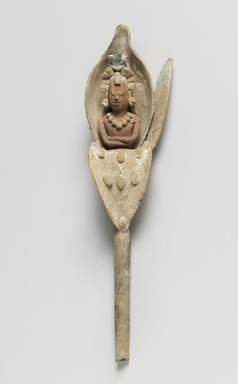Browse

| Accession # | 70.31 |
|---|---|
| Culture | Maya |
| Title | Maize God Emerging from a Flower |
| Date | 600-900 |
| Medium | Ceramic, pigment |
| Dimensions | 8 1/4 x 2 1/8 x 1 11/16 in. (21 x 5.4 x 4.3 cm) |
| Credit Line | Dick S. Ramsay Fund |
| Location | American Identities: Inventing American Landscape |
| Description | The delicately modeled ceramic figurine is Jaina in style and reveals the upper part of a figure emerging from a flower. The figure is red with ornaments (necklace, earrings, and headdress) in cream color. The tip of the headdress is blue. There are other trace amounts of blue on the stem and petals of the flower. The figure's arms are folded across the waist. The flower, possibly a water lily has three pointed petals: one is in the front-center section, turned downward, exposing the inside texture of the flower that is handled with an application of clay dots; a second stands upward in the back, enveloping the figure; and a third stands upward on the proper left side of the lily. Because the water lily is associated with the Underworld in Maya cosmology, this figurine may symbolize the renewal of life after death. Condition; good; there are two repaired breaks in the stem and two repaired breaks in the headdress. There are also two broken edges at the proper right side of the blue central portion of the headdress, probably where two appliquéd segments had been attached. |
Curatorial Remarks: About this Brooklyn Icon
The Brooklyn Museum is commemorating its 200th anniversary by spotlighting 200 standout objects in its encyclopedic collection.
Venerated across the Maya region—a vast territory that includes the present-day countries of Mexico, Belize, Guatemala, and Honduras—the Maize God is often depicted as a metaphor for new growth and regeneration. He also symbolizes agricultural fertility and abundance.
As seen in this delicate ceramic object, the Maize God is identified by an elongated head, reminiscent of an ear of corn, and the idealized features of a beautiful young man. He wears a beaded necklace and ear spools, ornaments that were made of jade, a precious stone associated with the living maize plant. In Maya creation stories, the Maize God dies, descends into the underworld, and is reborn—a metaphor for the corn seed that emerges with new life from the ground.
Also according to the Maya worldview, ancestors and deities reside on Flower Mountain, a paradise full of music and beautiful, fragrant flowers. Made during the Late Classic Period, this work doubles as a whistle that was likely played during special ceremonies. It reflects the concepts of flowers as homes for divine beings and music as a means to bring these beings to life.
.***
Gallery Label
In this ceramic figurine, the young Maize God emerges from a flower. He is identified by an elongated head, reminiscent of an ear of corn, and idealized facial features. He wears a beaded necklace, ear spools, and a headdress, indicating this high status. When the Maize God dies, he descends into the underworld and is reborn—a metaphor for the seed of corn that emerges with new life from the ground. He was a symbol of agricultural fertility, abundance, and renewal. According to Maya worldview, ancestors and deities reside in Flower Mountain, a paradise full of music and beautiful, fragrant flowers. This object reflects the concepts of flowers as homes for divine beings and music as a means to bring these beings to life.
—Diana Cristina Rose, Mayan descent, independent scholar of pre-Hispanic and contemporary Maya art